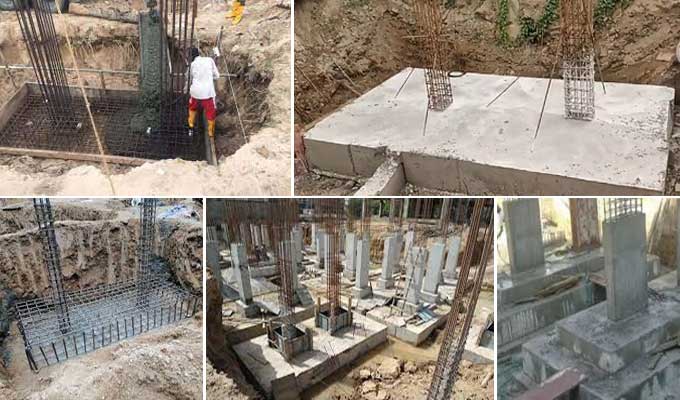
What are the Types & Benefits of Combined Footing & why are they used?
Combined Footing refers to several columns in a straight line that spreads out over a single spread footing. When two columns are close together, the soil bearing capacity is lower and the combined footing use is higher. It is better to provide a combined footing than separate isolated footings when two columns are close together. The cost of isolated footings is typically lower.
When you use Combined Footing
Combination footings can take the shapes of rectangles, trapezoids. It is ultimately necessary to achieve uniform pressure distribution under the entire footing area. It is best to align the center of gravity of the footing area with that of the total load of two or more columns.
- There is an overlap of two adjacent columns.
- Isolated footings overlap due to low soil bearing capacity.
- Building lines, existing buildings, or sewers are columns that can find near a building.
Types of Combined Footing
Rectangular Footing
When one of the projections of a footing is restricted or when the footing's width is restricted, a rectangular footing is used.
Trapezoidal Footing
When the load on one column exceeds the load on another, a trapezoidal footing requires. The trapezoidal column must always carry the heavier load when an outer column is near the boundary line to bring the C.G of the footing line with the C.G of the total load of the column.
Strap Footing
An eccentric load on the part of a footing will result from the strap combined footing where one column sits on a property line. As a result, add a beam in the footing to restrain the effect of overturning.
Raft Footing
There are several types of Combined Footing, but Raft Footing is one that covers the entire area beneath a structure and supports all its walls & columns.
Designing Process of Combined Footing
- On the footing, determine where the column loads will be applied.
- To ensure the resultant loads pass through the center of the footing, proportion the footing accordingly.
- In order to avoid exceeding the allowed soil pressure, calculate the area of the footing.
- From the maximum bending moment, determine the depth of footing.
- Plan the depth and reinforcement of the transverse section after calculating the transverse bending moment.
- Make sure that anchorages and shears are in place.
- In order to design the longitudinal steel, check the footing for longitudinal shear.
- Prepare the reinforcements for the longitudinal moment and place them in the correct locations.
- Make sure the longitudinal steel development length is correct.
- For the economy, reduce the longitudinal bars.
- Describe the reinforcement in detail.
- Create a schedule for bar bending.
Benefits of Combined Footing
- A combined footing is advantageous when there are two or more columns constructed within a small space.
- Combined footings can also construct where soil bearing capacity is low.
- We constructed combined footings when the soil capacity of the Construction area was insufficient to distribute the load evenly.
- Combining footings enables the construction of a column across a property line when footings are not spread across the front of the property line.
- The combined footing is widely used to maintain the column's center of gravity and achieve uniform pressure distribution.
- It is more profitable to build this type of footing than another type.
- In combination footings, the load is evenly distributed from the superstructure to the subsoil.
- It is because two or more columns share a combined footing.
- Construction sides with difficult ground conditions can benefit from the combined footing.
Drawbacks of Combined Footing
- A common disadvantage of combined footings is that the groundwater level rises. As a result, the soil is no longer in contact with the foundation.
- Heat difference may be a problem if the foundation raft thickness is high.
- Due to the use of a common footing for many columns, the footing area has been reduced.
- Columns in combined footing have a difficult time maintaining their center of gravity.
- Combining footings has the general disadvantage that their sizes must vary depending on the place. Occasionally, rectangular footings should construct, other times trapezoidal ones.
Wrapping it Up
Currently, reinforced concrete dominates structural systems. Structures rest on foundations, which touch the ground directly and transfer the load to the soil. Footings transmit forces to the soil, such as vertical loads, horizontal loads, moments, etc.
This is because it transfers the weight of the structure to the ground in a safe manner. In overstressed soils, shear failure can cause the soil to slide along a rapture plane, ultimately resulting in collapse.
To get more details, watch the following video tutorial.
Video Source: Civil Engineers


